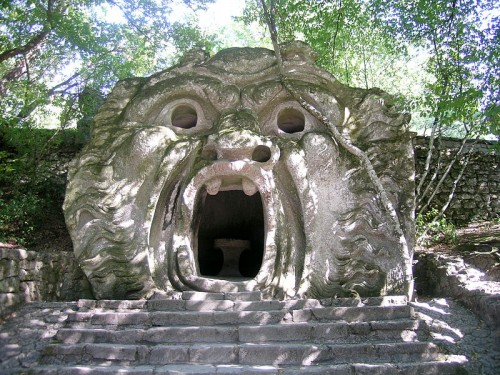MOUTH OF HELL: Infernal Visions at the Edge of Consciousness
 Mouth of Hell
Mouth of Hell
by María Negroni
Translated by Michelle Gil-Montero
Action Books, April 2013
112 pages / $16 Buy from Action Books or SPD
“So dark and deep and nebulous it was,
try as I might to force my sight below,
I could not see the shape of anything.” –– Dante, Inferno, Canto IV
“Then existence was a must, and I remain unborn. I’ve traveled with ghosts, or worse, drudged through discontent, destroying what I desired, which didn’t exist. Awkward to thrive as humanity atrophies, only to shelter in a garden of stones. And yet, in all that dismal jubilance, something sings: the soul, a tiny light that sounds among great monsters, growing always more equal to itself, thirstier for white words.” –– María Negroni, Mouth of Hell
***
Mouth of Hell is inspired by Manuel Mujica-Lainez’s Bomarzo, a novel I’ve never read, which itself is based on the eccentric Duke Pier Francesco Orsini, a 16th century nobleman who commissioned a sacred garden of monsters to be built in his honor. Negroni’s Mouth of Hell is composed of brief untitled prose poems, the proclamations of the decadent aesthete Orsini at the exact point of his death, which occurs inside the garden’s hellish grotto. These poems act as jolts of energy and are the culmination of a peculiar life as seen from the edge of consciousness.
Jorge Monteleone’s superb introduction and the translator’s preface do excellent service to shed some light on the historical Duke Orsini as well as the novel Bomarzo. This convergence of sources and voices sort of mirrors the fragmentation and reconstitution of selfhood that occurs in these poems, all happening in the heightened reality of the monstrous sculpture garden, “my biography and my park of monsters, who I’ve despised, envied, admired, and loved, deep down, terribly.” Speaking of the park’s sculptures, Orsini said, “Each rock represented an enchanted figure, in my memory or imagination.” Each poem in Mouth of Hell could do the same, creating a fascinating interplay of life, art, creation, dissolution, and rejuvenation of the senses.
“A lot could be said of my hideout. It is here where I ruminate and write, where I wield my inhuman right to dissent. Deep in the light, I draw my self-portrait: the high signs of a fearsome counterdance. Here, I play at life. Nestled like a hoard of jewels, I even possess what I’ve denied myself. In a word, I play with death. My den is motionless. Like the world, an untouchable relic within.”
Mouth of Hell, in part, chronicles a human soul gaining knowledge of itself upon death. These are finely tuned revelations of deranged nobility, commemorating “a lascivious earth to an uncertain beyond, the thread of my hallucinated life.” These are memories, sensations, fantasies, and proclamations of “the body whirling into conviction” at the brink of death. For this reason it occasionally feels like a radically condensed take on Dante’s Inferno.
“The forest dark as ever, without latitudes. An aide-de-camp to say something about nothing and guide us up the river of blood. As if there were cover under human tabula. Things strewn here and here, for worse and better. And later, in the middle of the road, the end of the endless, an immense door, passable and impassable, like the glacial spaces of the soul.”
Orsini’s garden of monsters remains after hundreds of years a singular artistic oddity. Monteleone informs us that above the crude demonic mouth is the inscription, “Lasciate ogni pensiero voi ch’entrate,” which can be translated, “Abandon all thought ye who enter.” This curious variation on Dante’s famous line suggests a total annihilation of the personal self. A journey into the underworld is nothing less than a chance to merge with the archetypal, with the infinite formless monsters of the abyss.

The sculpture garden, “the estate of the sensual,” is a monument of excess, and the demonic face that graces the cover of this book is as comically grotesque as any of Iron Maiden’s album covers. The opening of the mouth serves as a meeting place of two worlds. Just as death is the edge of life, the brink of the abyss is the edge of the visible.
August 26th, 2013 / 11:05 am
